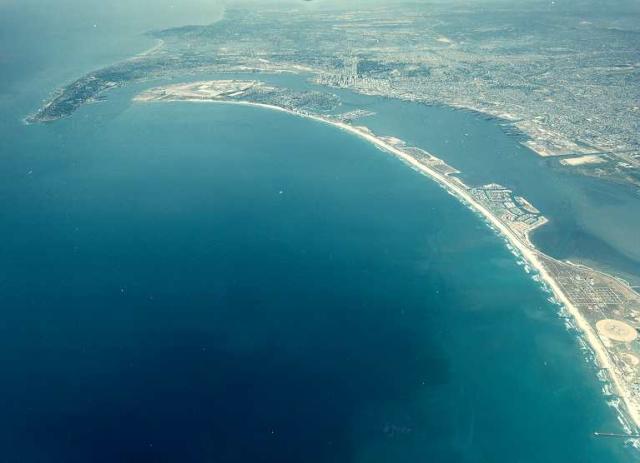
General Information
San Diego Harbor is a major naval, commercial, and recreational center for the southwest United States. It is at the extreme southern limit of California's coast, approximately 110 miles south of Los Angeles and several miles north of the Mexican border. Crescent-shaped, the 18-mile long Harbor and Bay area are separated from the ocean by the "Silver Strand," a low peninsula that has undergone both residential and recreational development. Entry to the Harbor is through the single, north channel entrance.
To enter San Diego Harbor, ships must travel north, for four miles, through the channel, from Point Loma at the northern end of the Silver Strand, then turn east for several miles, and, finally, south to access the central and southern harbor areas. The Municipal Yacht Basin and Commercial Fish Harbor near Shelter Island are closest to the harbor entrance. The Approach and Entrance channel depth is -55 feet and Main channel depths are -47 feet from the entrance to the Turning Basin.
The harbor serves the San Diego metropolitan area and is a major shipping point for agricultural goods from southern California, Arizona, and New Mexico. Approximately 3.3 million metric tons of cargo passed through the port in fiscal year 2006-2007. The U.S. Navy’s Third Fleet is also headquartered in San Diego Bay and several Nimitz-class aircraft carriers are homeported there. Numerous ancillary commands are also based in and around the San Diego Harbor area including submarine bases and naval shipyards.
Recreational use of the harbor is significant. There are at least 4,000 boat slips in use for privately owned recreational craft, and a high demand for additional slips. The commercial sport-fishing fleet numbers about 50 boats and carries approximately 100,000 persons per year. Also, the harbor is the center of the west coast commercial tuna fishing industry, harboring one of the largest tuna-fishing fleets in the world.
Major harbor facilities are concentrated on the east side of the central harbor, fronting U.S. Highway 101 and a major north-south railway. A tourist pier area at the north end of the harbor adjoins the naval anchorage, which extends south to the Tenth Avenue Terminal, a bulk-loading area (primarily grain).
Most recreation facilities are near the north end of the harbor or along the shore of the Silver Strand peninsula. Shelter Island and Harbor Island protect numerous facilities, and the commercial fish harbor between them is used by commercial and party boats.
Recreational activities in the Harbor include power boating, sailing, water skiing, swimming, fishing, clamming, wading, and picnicking. Private and public marinas, small boat anchorages, and yacht and boat clubs around the harbor provide slips or mooring spaces for over 4,800 vessels (Corps of Engineers 1975). More than 100,000 sport fishermen depart annually on commercial sport-fishing boats to fish in the offshore waters around Coronado Island, and in kelp beds along the county's shoreline.